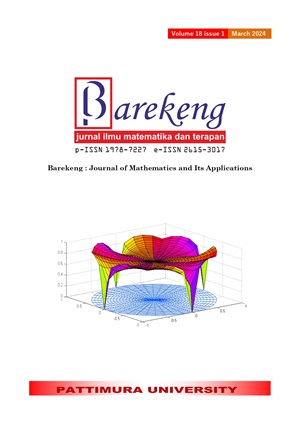C PROGRAM AS A TOOL FOR THE TEACHING OF SECOND ORDER ORDINARY DIFFERENTIAL EQUATION
Abstract
Second order ordinary differential equation (ODE) has many applications in science and engineering. Undergraduate students in science and engineering departments must study this subject in order to understand other subjects which are related to real applications they will encounter later. There are many excellent textbooks on differential equations where the students can study the theory and solve the problems. However, a textbook cannot give a quick answer for a problem particularly when the problem is quite difficult. A good choice is to use software such as Maple or Mathematica. However, this software is not always available for the teaching and purchasing it is usually beyond the ability of a student or even a lecturer. On the other hand, lecturers who want to create problems by themselves will follow the theory of the ODE. While creating the problems may not be difficult, answering them are harder. Problems which are very easy to answer are less worthless because they will not increase the students’ knowledge. Here comes the solution. A C program has been created to help lecturers create problems and solve them quickly. The program is interactive and can be easily understood by anyone who has basic theory of ODE. No knowledge of programming is needed; a user just runs it and follows the instruction. Students can also use the program to sharpen their knowledge. They can compare the solution of a problem they have solved with the answer given by the program. While commercial software such as Maple and Mathematica is very powerful, they cannot be used without writing necessary commands to solve a problem.
Downloads
References
R. P. Agarwal and D. O’Regan, Ordinary and Partial Differential Equations With Special Functions, Fourier Series, and Boundary Value Problems. New York: Springer Science Business+Media LLC, 2009.
J. Bird, Comprehensive Engineering Mathematics Second Edition. New York: Routledge, 2018.
D.B. Meade, W. E. Boyce, and R. C. DiPrima, Elementary Differential Equations and Boundary Value Problems., 11 th Edit. Hoboken: John Wiley and Sons Inc., 2017.
S. B. Hsu, Ordinary Differential Equations with Applications Second Edition. Singapore: World Scientific, 2013.
S. A. Wirkus, R. J. Swift, and R. S. Szypowski, A Course in Differential Equations and Boundary-Value Problems Second Edition. Boca Raton: Taylor & Francis Group LLC, 2017.
D. G. Zill and M. R. Cullen, Differential Equations with Boundary-Value Problems Seventh Edition. Belmont: Brook/Cole, 2009.
A. D. Polyanin and V. F. Zaitsev, Handbook of Ordinary Differential Equations: Exact Solutions, Methods, and Problems. Boca Raton: Taylor & Francis Group LLC, 2018.
R. Tahir-Kheli, Ordinary Differential Equations: Mathematical Tools for Physicists. Switzerland: Springer Nature, 2018.
J. P. Holman, Heat Transfer Tenth Edition. New York: McGraw-Hill, 2010.
A. D. Kraus, A. Aziz, and J. Welty, Extended Surface Heat Transfer. New York: John Wiley & Sons Inc., 2001.
F. Golnaraghi and B. C. Kuo, Automatic Control Systems Ninth Edition. New York: John Wiley, 2010.
K. Ogata, Modern Control Engineering Fifth Edition. Upper Saddle River: Prentice Hall, 2010.
J. S. Cohen, Computer Algebra and Symbolic Computation. Mathematical Methods. Press Boca Raton: A K. Peter/CRC, 2003.
W. Gander and J. Hřebíček, Solving problems in Scientific Computing Using Maple and MATLAB Fourth Edition. Berlin-Heidelberg: Springer-Verlag, 2004.
I. Shingareva and C. Lizarraga-Celaya, Maple and Mathematica: A Problem Solving Approach for Mathematics. New York: Springer Verlag/Wien, 2009.
M. Olsson, Modern C Quick Syntax Reference. New York: Apress, 2019.
S. Chavan, C Recipes: A Problem-Solution Approach. New York: Apress, 2017.
N. Kalicharan, Learn to Program with C. New York: Apress, 2015.
P. Prinz and T. Crawford, C in a Nutshell Second Edition. Sebastopol: O’Reilly, 2016.
W. E. Schiesser and H. J. Lee, Ordinary and Partial Differential Equation Routines in C, C++, Fortran, Java, Maple, and MATLAB. Boca Raton: Chapman & Hall/CRC, 2004.
D. S. Malik, C++ Programming: From Problem Analysis to Program Design Fifth Edition. Boston: Cengage Learning, 2011.
G. S. Tselikis and N. D. Tselikas, C: From Theory to Practice Second Edition. Boca Raton: Taylor & Francis Group LLC, 2017.
Copyright (c) 2024 Harahap Amin, Zahedi Zahedi, Lolang Enus, Ansoruddin Ansoruddin, Wingkolatin Wingkolatin, Efendi Efendi

This work is licensed under a Creative Commons Attribution-ShareAlike 4.0 International License.
Authors who publish with this Journal agree to the following terms:
- Author retain copyright and grant the journal right of first publication with the work simultaneously licensed under a creative commons attribution license that allow others to share the work within an acknowledgement of the work’s authorship and initial publication of this journal.
- Authors are able to enter into separate, additional contractual arrangement for the non-exclusive distribution of the journal’s published version of the work (e.g. acknowledgement of its initial publication in this journal).
- Authors are permitted and encouraged to post their work online (e.g. in institutional repositories or on their websites) prior to and during the submission process, as it can lead to productive exchanges, as well as earlier and greater citation of published works.






1.gif)



